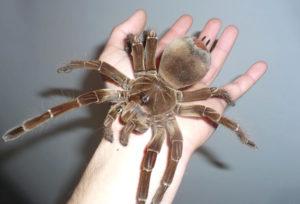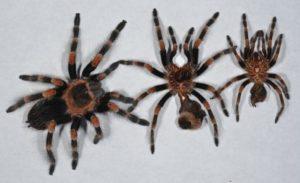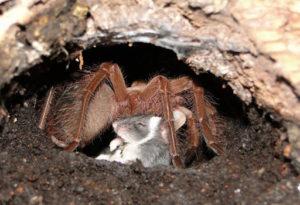Tarantula goliath: a fearsome large spider
The Goliath spider is a large species of arthropod. It is known for its memorable and colorful appearance. This species is poisonous and has a number of differences from other tarantulas.
Content
What does a goliath look like: photo
Goliath spider: description
Name: Goliaf
Latin: Theraposa blondiClass: Arachnida - Arachnida
Squad: Spiders - Araneae
family: Tarantulas - Theraphosidae
 | Habitats: | rainforests |
 | Dangerous for: | small insects, pests |
 | Attitude towards people: | rarely bites, not aggressive, not dangerous |
The color of the spider can be from dark brown to light brown. On the limbs there are weak marks and hard, thick hairs. After each molt, the color becomes even brighter. The largest representatives reach a length of 13 cm. Weight reaches 175 grams. Leg span can be up to 30 cm.
On the segments of the body there is a dense exoskeleton - chitin. It prevents mechanical damage and excessive moisture loss.
The cephalothorax is surrounded by a solid shield - carapace. There are 4 pairs of eyes in front. In the lower part of the belly there are appendages with which the goliath weaves a web.
Molting affects not only the color, but also the length. Goliaths increase after molting. The body is formed by the cephalothorax and belly. They are connected by a dense isthmus.
Habitat
Favorite habitat is the deep burrows of the Amazon rainforest. Goliath loves swampy terrain. He is afraid of the bright rays of the sun. The optimum temperature is from 25 to 30 degrees Celsius, and the humidity level is from 80 to 95%.
goliath diet
Goliaths are real predators. They eat animal food, but rarely eat meat. The spider does not catch birds, unlike many of its fellow tribesmen. Most often, their diet consists of:
- small rodents;
- invertebrates;
- insects;
- arthropods;
- fish;
- amphibians;
- worms;
- rodents;
- frogs;
- toads;
- cockroaches;
- mukh.
Life
Spiders are in hiding most of the time. Well-fed individuals do not leave their shelter for 2-3 months. Goliaths are prone to a solitary and sedentary lifestyle. May be active at night.
Arthropod habits change with the life cycle. They usually settle closer to plants and trees in order to find more prey. Individuals that live in the crown of a tree are excellent at weaving webs.
Young goliaths molt monthly. It promotes growth and color improvement. The life cycle of females is from 15 to 25 years. Males live from 3 to 6 years. Arthropods defend themselves from enemies with the help of an attack with excrement, poisonous bites, and burning villi.
Goliath life cycle
Males live less than females. However, males are able to become sexually mature earlier. Males before mating engage in web weavinginto which they release seminal fluid.
Next comes a special ritual. Thanks to him, arthropods determine the genus of their pair. Rituals consist of shaking the torso or tapping with paws. With the help of special tibal hooks, males hold aggressive females.
Sometimes mating happens instantly. But the process can take up to several hours. Males carry seminal fluid with the help of pedipalps into the body of the female.
Next, the female makes a clutch. The number of eggs is from 100 to 200 pieces. The female is engaged in the construction of a kind of cocoon for eggs. After 1,5 - 2 months, small spiders appear. At this time, females are aggressive and unpredictable. They protect their cubs. But when they are hungry, they just eat them.
Natural enemies
Such large and courageous spiders can also fall prey to other animals. The enemies of goliaths include:
goliath bite
Spider venom does not pose a particular danger to humans. Its action can be compared with that of a bee. Of the symptoms, pain at the site of the bite, swelling can be noted. Much less often, a person experiences acute pain, fever, cramps, and an allergic reaction.
Data on deaths in humans after a spider bite are not available. But bites are dangerous for cats, dogs, hamsters. They can lead to the death of pets.
First aid for goliath bite
When a goliath bite is detected, you must:
- apply ice to the wound;
- wash with antibacterial soap;
- drink plenty of fluids to remove toxins;
- take antihistamines;
- if the pain worsens, consult a doctor.
Often it is the representatives of this family that are often pets. They are calm and easily adapt to the conditions of life in a confined space. It is not recommended to have goliaths if you have small fly or allergies.
Conclusion
Goliath is an exotic species of arthropod. Some people keep it as a pet, and South Americans add it to their food. While traveling, you should be careful and careful not to provoke the goliath to attack.


